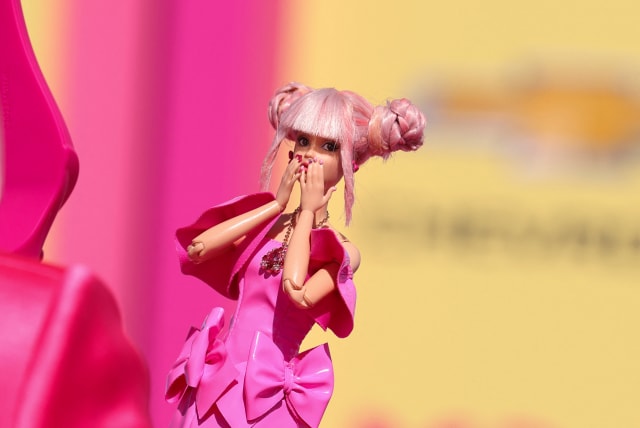Is Barbie Jewish? The complex Jewish history of the doll, explained

Handler created Barbie in 1959, when many Jews were wrestling with the concept of assimilation.
Long before the craze over the upcoming “Barbie” movie, most people could conjure an image of the doll: She was the beauty standard and the popular girl, a perky, white, ever-smiling brand of Americana.
She was also the child of a hard-nosed Jewish businesswoman, Ruth Handler, whose family fled impoverishment and antisemitism in Poland. And some see the original Barbie as Jewish like Handler, a complex symbol of assimilation in the mid-20th-century United States.
The doll’s latest revival comes in Greta Gerwig’s hotly-anticipated “Barbie” movie, written by Gerwig and Noah Baumbach and featuring a star-studded cast, including Margot Robbie as Barbie, Ryan Gosling as Ken and Will Ferrell as a fictional CEO of Mattel. The expected blockbuster could collect at least $70-80 million in just its opening weekend of July 21-23, according to The Hollywood Reporter, fueled in part by a relentless marketing machine.
But this in-crowd doll was born from an outsider. Here’s its Jewish history.
The origin story of Barbie
Ruth Handler was born in 1916 in Denver, Colorado, the youngest of 10 children. Her father, Jacob Moskowitz (later changed to Mosko) had escaped conscription in the Russian army like many Jews at the turn of the century, and landed in the United States in 1907. Her mother Ida, who was illiterate, arrived the next year in the steerage section of a steamboat. Jacob was a blacksmith and moved the family to Denver, where new railroads were being built.
Ida was sickly by the time she gave birth to Ruth, so the baby was sent to live with her older sister Sarah. It was in Sarah’s Jewish community of Denver, when Ruth was 16 years old, that she met Izzy Handler at a Jewish youth dance, according to Robin Gerber, a biographer who wrote “Barbie and Ruth: The Story of the World’s Most Famous Doll and the Woman Who Created Her.” She fell in love immediately with Izzy, a penniless art student wearing a torn t-shirt.
At age 19, Ruth decided to drop out of the University of Denver and move to Los Angeles, where she found a job as a secretary at Paramount Studios. Izzy soon followed her.
“As they drove across the country, she asked him to change his name to Elliot,” said Gerber. “She had felt the antisemitism at that time, in the 1930s, and she really felt that they’d be better off with a more Americanized name.”
The couple never renounced their Judaism. On the contrary, they eventually helped found Temple Isaiah in Los Angeles and became longtime contributors to the United Jewish Appeal. But Ruth was pragmatic, and she would not forget how police officers had stopped her car in Denver to make antisemitic remarks.
Against the pleadings of her family, who knew Elliot was poor, Ruth married him in 1938. She continued working at Paramount, while he enrolled at the Art Center College of Design and took a job designing light fixtures — but they quickly became collaborators. Elliot began making pieces from Lucite in their garage, such as bookends and ashtrays, and Ruth was thrilled to sell them. They were complementary business partners: Elliott was a quiet creative who shied away from ordering in a restaurant, while Ruth was vivacious and unafraid, a risk-taker who said her first sale felt like “taking a drug,” according to Gerber.
World War II challenged their business, as President Franklin Roosevelt restricted plastics to military use. Together with their friend Harold “Matt” Matson, the Handlers pivoted to making wooden picture frames and dollhouse furniture. They found success and named their company Mattel, a combination of Matt and Elliot’s names.
In 1946, Matson sold his share and Ruth Handler became the first president of Mattel. The company soon branched into toys, including a child-sized ukulele called the Uke-A-Doodle, a Jack-in-the-Box and toy guns. Since the design department was entirely male, many of its early toys targeted little boys.
One day, while watching her daughter Barbara — who would become Barbie’s namesake — Ruth had a new idea. She observed that Barbara and her friends were playing with paper dolls and pretending to be adult women. In the 1950s, the only dolls on the market were baby dolls, presuming that girls wanted to play at being mothers. But Barbara and her friends wanted to play being the dolls.
On a family trip to Switzerland in 1956, she spotted a curvaceous adult doll called Bild Lilli. This toy, based on a seductive comic strip character in the German tabloid Bild, was designed as a sexual gag gift for men. Ruth saw her as a blueprint for Barbie.
An adult female doll for children was so novel that Mattel’s designers and even Ruth’s husband dismissed the idea, saying that mothers would never buy their daughters a doll with breasts. Ruth kept pushing until the first Barbie, decked in a black-and-white swimsuit and heels, debuted at New York’s Toy Fair in 1959.
Sure enough, plenty of mothers said the doll was too sexual — but their daughters loved it. Ruth communicated directly with children by bringing Mattel to television, making it the first toy company to advertise on Disney’s “Mickey Mouse Club.”
“She completely shifted the way we buy toys,” said Gerber. “Up to that point, children only saw toys when their parents handed them a catalog. But when toys came to ads on television, then kids were running to their parents and saying, ‘I want that thing on TV.’”
Mattel sold 350,000 Barbies in its first year. Striving to keep up with demand, the company released her boyfriend in 1961 and named him after the Handlers’ son, Kenneth.
Is Barbie feminist? Sexist? Assimilationist? Jewish?
Barbie’s rail-thin figure sparked backlash from feminists in the 1970s. “I am not a Barbie doll!” became a chant for marchers at the 1970 Women’s Strike for Equality in New York. Advocacy groups such as the South Shore Eating Disorders Collaborative have said that if Barbie were a real woman, her proportions would force her to walk on all fours and she would not have enough body fat to menstruate. In the 2018 film “Tiny Shoulders: Rethinking Barbie,” Gloria Steinem said, “She was everything we didn’t want to be.”
Handler said that Barbie represented possibilities for women. Women could not open a credit card in their own name until 1974, but Barbie could buy any outfit to fit any career. Her fashion represented the future: Astronaut Barbie came out in 1965, four years before Neil Armstrong walked on the moon and 18 years before Sally Ride became the first American woman in space. Ken may be Barbie’s boyfriend, but in more than 60 years, she has not married or had children.
In Ruth’s memoir “Dream Doll: The Ruth Handler Story,” she wrote, “Barbie has always represented the fact that a woman has choices. Even in her early years Barbie did not have to settle for being only Ken’s girlfriend or an inveterate shopper. She had the clothes, for example, to launch a career as a nurse, a stewardess, a nightclub singer.”
But years before the feminist discussion, the question of how American Jews could or could not relate to Barbie said a lot about their place in the United States at the time. Handler created Barbie in 1959, when many Jews were wrestling with the concept of assimilation. Although they continued to face discrimination in the postwar period, they also had newfound security — a life they had never identified with, according to Emily Tamkin, the author of “Bad Jews: A History of American Jewish Politics and Identities.”
Suddenly, like so many others, they were moving to suburban, white-picket fence America — Barbie territory.
So, much like the iconic fashion of Ralph Lauren, a Jewish designer who changed his last name from Lifshitz, or the Christmas Carols of Irving Berlin, a Russian Jewish immigrant born Israel Beilin, Barbie would paradoxically become core to the American ideal that Jews were seen to assimilate into, said Tamkin.
“The thinking goes, if you’re safe and secure and in suburbia, is that really an authentic Jewish life?” Tamkin told the Jewish Telegraphic Agency. “And while they’re having this communal and individual struggle, Ruth Handler really enhances the Americana that they have this ambivalence about.”
But was the original Barbie actually Jewish herself? Susan Shapiro, the best-selling author of “Barbie: 60 Years of Inspiration,” thinks so.
“I think Ruth just assumed that Barbie reflects her, in a certain way,” Shapiro told Kveller in 2019. “Barbie was supposed to be all-American, and I think Ruth really considered herself to be very assimilated in America. But she did face antisemitism at Paramount Pictures, and her family fled Europe because of antisemitism.”
The doll doesn’t fit the rubric of stereotypes about Ashkenazi appearance — after all, her first form copied a German sex doll that “looks very goyishe,” said Gerber. (Non-white Barbie ethnicities were not introduced until the 1980s.)
Tiffany Shlain, who made a 2005 short documentary “The Tribe” about the history of Jews and Barbie, is herself a blond, blue-eyed Jewish woman (who wrote the film with her husband, serendipitously named Ken Goldberg). She was often told that she didn’t “look Jewish.”
“Right now, we’re in a real renaissance of seeing all the different ways Jews look, and there’s no ‘look,’ there’s no one ideology,” Shlain said.
Regardless of what American buyers think, Barbie has been labeled “Jewish” by discriminatory bans. In 2003, she was temporarily outlawed by Saudi Arabia’s religious police, who posted the message: “Jewish Barbie dolls, with their revealing clothes and shameful postures, accessories and tools are a symbol of decadence to the perverted West.” Iran has also repeatedly cracked down on the sale of Barbies since declaring them un-Islamic in 1996.
Will the new movie address any of this?
It’s unclear.
Gerwig’s collaborator (and partner) Baumbach is Jewish but doesn’t often reference that fact in his movies, which include “The Squid and the Whale” and “Marriage Story.” The film features a few Jewish cast members, including Hari Nef, a trans actress and model who has appeared in shows such as “Transparent,” “The Marvelous Mrs. Maisel” and “The Idol.”
Details about the movie’s plot have been scarce, but it seems to involve characters leaving a make-believe Barbie world for the real world.
The wide diversity of the cast — which features several different actors playing Barbie and Ken — also seems to be a commentary on Barbie’s white, all-American roots.
“We were able to cast people of different shapes, sizes, differently abled, to all participate in this dance — all under this message of: You don’t have to be blonde, white, or X, Y, Z in order to embody what it means to be a Barbie or a Ken,” said actor Simi Liu, who plays one of the Kens.
Jerusalem Post Store
`; document.getElementById("linkPremium").innerHTML = cont; var divWithLink = document.getElementById("premium-link"); if (divWithLink !== null && divWithLink !== 'undefined') { divWithLink.style.border = "solid 1px #cb0f3e"; divWithLink.style.textAlign = "center"; divWithLink.style.marginBottom = "15px"; divWithLink.style.marginTop = "15px"; divWithLink.style.width = "100%"; divWithLink.style.backgroundColor = "#122952"; divWithLink.style.color = "#ffffff"; divWithLink.style.lineHeight = "1.5"; } } (function (v, i) { });

